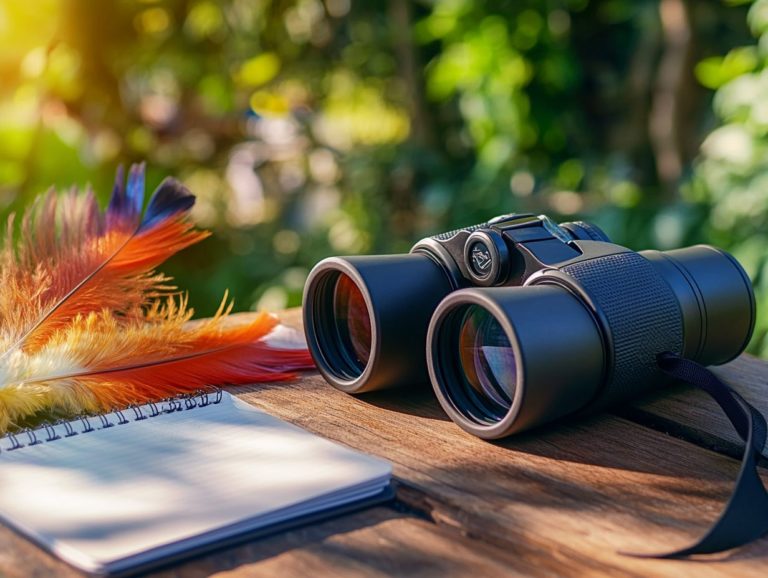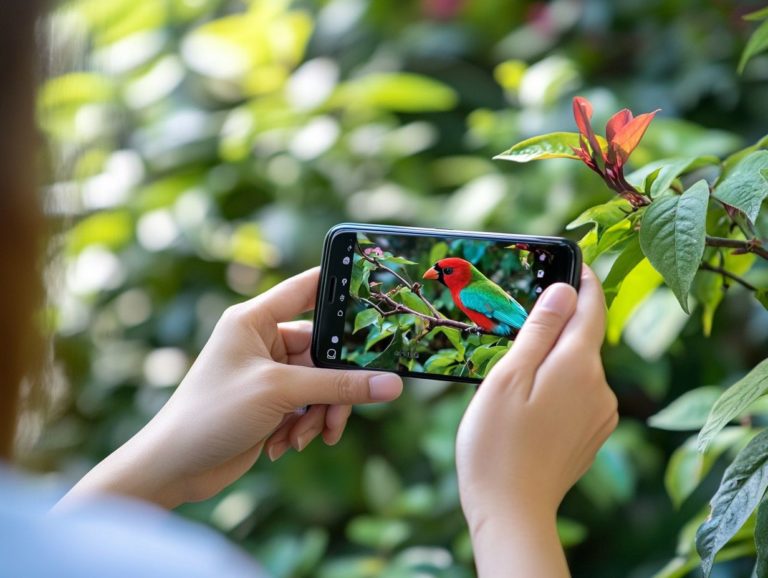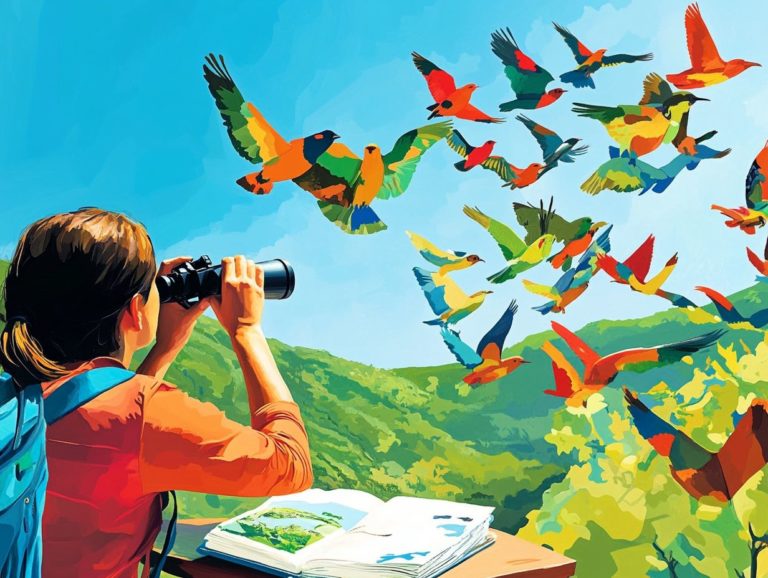How Do I Spot Birds Near Bodies of Water?
Water is essential for birds. It provides habitat and is a vital resource.
Get ready to discover the captivating world of water birds! We’ll highlight common species found near lakes, rivers, and wetlands, as well as in hotspots like backyard gardens and urban lakes.
You will learn how to identify these birds using visual and auditory cues. Discover the best birding locations and get tips to enhance your birdwatching experience.
Whether you’re just starting out or have years of experience, there’s something for everyone. Explore local parks or engage with citizen science platforms like eBird.
Contents
- Key Takeaways:
- Types of Birds Found Near Bodies of Water
- Identifying Birds Near Bodies of Water
- Best Locations for Bird Spotting Near Water
- Tools and Techniques for Bird Spotting Near Water
- Frequently Asked Questions
- How do I spot birds near bodies of water?
- What types of birds can I expect to see near bodies of water?
- Do I need any special equipment to spot birds near bodies of water?
- When is the best time of day to spot birds near bodies of water?
- Are there any safety precautions I should take when spotting birds near bodies of water?
- Can I attract birds to bodies of water to make spotting them easier?
Key Takeaways:
- Look for bright colors and listen for unique calls to spot birds near water.
- Visit wetlands, lakes, and estuaries to increase your chances of seeing various water birds.
- Use binoculars and field guides to enhance your birding experience and identify different water birds.
The Importance of Water for Birds
Water provides hydration and habitats for birds, especially in states like California and Texas. Many birds, including eastern phoebes, rely on water during migration for food and nesting sites.
Birds thrive in urban areas and parks with ponds, lakes, and rivers. These locations are crucial for birdwatching, particularly for those using bird feeders.
Notable habitats include the urban lakes of San Francisco and the marshes of the Texas Gulf Coast. Sewage treatment plants serve as important oases for waterfowl and shorebirds drawn to nutrient-rich environments.
Protecting these habitats ensures the survival of bird populations and enhances biodiversity. This invites more birdwatching enthusiasts to connect with nature.
Types of Birds Found Near Bodies of Water
Many bird species thrive in various water habitats found in parks and wildlife refuges. These areas are popular destinations for birdwatching.
The rich colors of waterfowl and the elegance of shorebirds make them prime locations for exploring biodiversity.
Platforms like eBird and the American Birding Association help birders track species across Important Bird Areas. Supporting these efforts is vital for conservation.
Common Water Birds and Their Characteristics
Common water birds, such as ducks, herons, and shorebirds, have unique features that help them thrive near water. They attract many visitors to birdwatching locations like Warren Dunes State Park. These birds show interesting behaviors when they migrate, using water as stops for feeding and resting.
Ducks often dabble or dive, using their broad bills to filter aquatic plants and small invertebrates. Herons are known for their elegance and hunt by sneaking up quietly before striking to catch fish. Shorebirds are fascinating too, with long legs and longer beaks that allow them to search mudflats for crustaceans and worms. Birders appreciate their beautiful feathers.
During migration, these birds rely on their natural navigation skills and special body features that help them fly long distances. They also have waterproof feathers to keep dry. These traits help them adapt to various habitats and make them attractive for birdwatchers eager to see their unique behaviors and colorful plumage.
Identifying Birds Near Bodies of Water
Identifying birds near water is a thrilling part of birdwatching. It involves recognizing the visual and auditory traits of different species, including those that visit backyard bird feeders.
Birding trails, lakes, and urban waterways are must-visit spots for birdwatching! There are many techniques birdwatchers can use to identify both common and rare species found in state parks, enhancing their birdwatching experience.
Visual and Auditory Cues
Visual and auditory cues are vital for recognizing birds near water. They help birders tell species apart and appreciate their behaviors, which strengthens community initiatives like Audubon.
For example, the vibrant blue and green plumage of male mallard ducks stands out against the drab brown feathers of females. The female’s loud quacks contrast with the soft calls of males, making them favorites among birdwatchers.
Herons, with their long and slender bodies, are often seen stalking silently near the water’s edge. Their throaty croaks and gentle clattering add to the excitement as they hunt for fish. These distinct traits enrich the birdwatching experience and foster appreciation for biodiversity and delicate ecosystems, like those in Florida and along the Great Texas Coastal Birding Trail.
Best Locations for Bird Spotting Near Water
Some of the best birdwatching locations near water include state parks, national wildlife refuges, and urban parks. These areas provide fantastic opportunities to see various bird species.
For instance, Central Park in New York City and the Great Texas Coastal Birding Trail are prime examples where birdwatchers can spot a wide range of species in different habitats, including the rich avian life at Love Creek County Park.
Recommended Birding Spots
Recommended birding spots, like the Texas Gulf Coast and California’s state parks, offer birdwatchers exceptional access to diverse bird populations against stunning natural backdrops. Migration seasons bring particularly active yard birds!
From the beautiful wetlands of the Texas Gulf Coast, known for colorful shorebirds like the Roseate Spoonbill and the Black Skimmer, to the lush forests of California’s coastal redwoods, where birders may spot the elusive Spotted Owl, each trail offers extraordinary experiences for birdwatching.
In New York City, Central Park acts as an urban oasis, drawing in migratory birds like the American Redstart and other species that thrive in urban settings, creating a striking contrast to the city’s hustle and bustle.
These locations not only highlight amazing biodiversity but also encourage community involvement through organized bird walks and educational programs. They invite enthusiasts of all ages to connect with nature and take part in conservation efforts, including those led by the American Birding Association.
Tools and Techniques for Bird Spotting Near Water
Using the right tools and techniques can greatly improve your bird-watching experience. With the right equipment, you can observe and identify birds more effectively, especially with Audubon recommendations.
Essential tools include binoculars, field guides, and technology like eBird. These resources help you track and report your sightings, making it easier to log your experiences in different habitats.
Binoculars, Field Guides, and Other Helpful Resources
Birding tools are crucial for enthusiasts. Binoculars allow you to observe distant species, while field guides help with identification. Online resources also aid in logging sightings.
These tools are especially beneficial in state parks, where a variety of bird species can often be found. Lakes, urban lakes, and waterways provide food and drinking spots for birds.
When choosing binoculars, consider factors like magnification—which indicates how much closer birds appear—lens diameter, and field of view. Higher magnification models are great for spotting elusive birds like hawks and owls.
Wider lenses deliver bright images, making them ideal for low-light conditions. Field guides are essential for bird identification, while digital platforms like eBird and Audubon Society tools help record sightings and track populations.
Collectively, these tools are game-changers for birding, benefiting both amateurs and experts.
Frequently Asked Questions
How do I spot birds near bodies of water?
Key techniques for spotting birds include looking for areas where water meets land, as many birds hunt and nest there. Scanning the water’s surface for movement or splashing can also indicate bird presence.
Lastly, use your ears to listen for bird calls or chirping!
What types of birds can I expect to see near bodies of water?
A variety of birds can be found near water, including waterfowl like ducks and geese, wading birds such as herons and egrets, and shorebirds like sandpipers and seagulls. The specific types depend on your location and the time of year.
Do I need any special equipment to spot birds near bodies of water?
While not necessary, binoculars or a camera with a zoom lens can greatly enhance your bird-watching experience. This allows you to see birds from a distance without disturbing them and capture unique or rare sightings.
When is the best time of day to spot birds near bodies of water?
The best times are typically early in the morning or late in the afternoon, when many birds are active. They can often be seen hunting for food or socializing. Different species may have varying peak activity times, so research the birds you hope to spot.
Are there any safety precautions I should take when spotting birds near bodies of water?
Yes! Always be aware of your surroundings and potential hazards. Be cautious of slippery surfaces and avoid getting too close to birds or their nests.
Also, stay mindful of any wildlife or weather hazards in the area.
Can I attract birds to bodies of water to make spotting them easier?
Yes! You can attract birds by offering food sources like seeds or mealworms near the water’s edge. However, do this responsibly and in accordance with local laws and regulations.
Overfeeding or attracting large numbers of birds to one area can negatively impact both the environment and the birds themselves.






